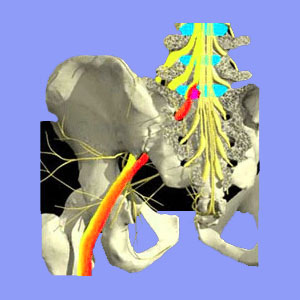
Sciatica pelvic pain can be a scary and very disturbing set of symptoms for any man or woman to experience. Pelvic pain can be an indicator of a wide range of structural health issues, but it can also be linked to the mindbody process and often is connected to highly charged, sensitive or repressed emotional issues. It is crucial to consider every possibility, since doctors are unlikely to diagnose regional ischemia, even though it is one of the most prevalent sources of sciatic nerve pain. Of course, the root cause can also lie with structural nerve issues, degenerative joint issues or muscular concerns, as well.
This dialog centers on explaining pelvic symptoms that are expressed in relation to a larger sciatica condition.
Anatomical Sciatica Pelvic Pain
The nerves which serve the pelvic area are diverse and can be influenced by a wide range of spinal causations, including spinal stenosis virtually anywhere in the spine, as well as foraminal stenosis which might impinge on some of the lumbar or sacral nerve roots.
The pelvic regions are prone to developing a multitude of health concerns including infections, tumors and other troublesome disorders, so it is crucial to rule out serious anatomical issues with your physician before beginning any traditional pelvic pain treatment plan.
Childbirth-related complications and female reproductive organ concerns may cause severe and chronic pelvic discomfort in some women and might also create pseudo-sciatica in their wake. I detail a variety of pregnancy and birth-related causes of sciatica pain elsewhere on the site.
Nonstructurally-Motivated Pelvis Pain
I receive many letters from readers who have unexplained pelvic agony, with or without associated back pain. Many times, this pain is related to emotional concerns which have been actively seeking conscious recognition, but are repressed by the subconscious mind. Unfortunately, many of these psychological issues are particular frightening, including a history of physical or sexual abuse or trouble with a current relationship.
Never underestimate the mind’s ability to enact physical symptoms in the body. These pains are not imaginary. They are indeed physical. However, their basis is not an anatomical concern, but rather, a completely psychological source using the autonomic system as the means of creating pain. To learn more, please read the full story about psychosomatic sciatica.
Sciatica Pelvic Pain Conclusions
Pelvic pain is some of the most difficult to accurately diagnose if preliminary testing does not bring back a verified structural conclusion. Many people suffer with long-term pelvic pain often stemming from particular life situations, such as having physically or emotionally uncomfortable sexual relations or sitting for too long.
These conditioned responses may well be the results of a structural issue. However, these anatomically-motivated conditions should be easy for your doctor to find and successfully treat. For unresolved pelvic pain, without bodily merit, I typically recommend investigating knowledge therapy, since the source may reside in the mind, not the body.




